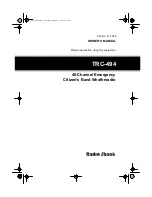
5-Pin M12/Euro-Style Male Quick Disconnect
Integral 5-pin M12/Euro-style male quick disconnects are wired for 10 V DC to 30 V DC power as shown.
5-pin M12/Euro-style (male)
Pin
Wire Color
Description
1
4
5
3
2
1
Brown
10 V DC to 30 V DC
2
White
3
Blue
DC common (GND)
4
Black
5
Gray
Set the MultiHop Radio (Slave) ID
The slave ID is an identifying number used for devices within a Modbus system. When using more than one Modbus slave, assign each slave a
unique ID number.
For MultiHop radios with rotary dials, use the rotary dials to set the device’s MultiHop Radio ID. The left dial sets the left digit and the right dial sets
the right digit.
• Modbus Slave IDs 01 through 10—Reserved for slaves directly connected to the host (local I/O). Polling messages addressed to these
devices are not relayed over the wireless link.
• Modbus Slave IDs 11 through 60—Use for MultiHop master, repeater, and slave radios. Up to 50 devices (local slaves and remote slaves)
may be used in this system.
If your MultiHop radio does not have rotary dials, you must use the master radio to set the Slave ID during the binding process.
MultiHop Configuration Software
Use Banner’s MultiHop Configuration Software to view your MultiHop radio network and configure the radio and its I/O.
The software connects to a MultiHop master radio using one of four methods.
• Serial; using a USB to RS-485 (for RS-485 radios) or a USB to RS-232 (for RS-232
radios) converter cable.
• Modbus TCP; using an Ethernet connection to an Ethernet radio master.
• Serial DXM; using a USB cable to a DXM Controller to access a MultiHop master
radio.
• TCP DXM: using an Ethernet connection to a DXM Controller to access a MultiHop
master radio.
For MultiHop DX80DR* models, Banner recommends using BWA-UCT-900, an RS-485 to USB adapter cable with a wall plug that can power your 1
Watt MultiHop radio while you configure it. The adapter cable is not required when connecting to a DXM Controller.
Download the most recent software revision from the Wireless Reference Library on Banner Engineering's website:
.
Installing Your Sure Cross
®
Radios
Please refer to one of the following instruction manuals for details about successfully installing your wireless network components.
• MultiHop Data Radio Instruction Manual:
Modbus Register Table
Serial Inputs (General). At every sample interval, a message is sent to the serial sensor to request sensor data. By default, registers are updated
every five minutes. Use the MultiHop Configuration Tool to change the sensors sample times.
Register (4xxxx)
Input #
I/O Type
101
1
Primary IN 1
102
2
Primary IN 2
103
3
Primary IN 3
104
4
Primary IN 4
105
5
Primary IN 5
106
6
Primary IN 6
Modbus Addressing Convention
All Modbus addresses refer to Modbus holding registers. When writing your own Modbus scripts, use the appropriate commands for interfacing to
holding registers. Parameter description headings refer to addresses in the range of 40000 as is customary with Modbus convention.
Install or Replace the Battery for a DX80 Integrated Battery Model
To install or replace the 3.6 V lithium "D" cell battery in any model with a battery integrated into the housing, follow these steps.
1. Remove the four screws mounting the face plate to the housing and remove the face plate.
2. Remove the discharged battery.
3. Install the new battery, verifying the battery’s positive and negative terminals align to the positive and negative terminals of the battery
holder mounted within the case.
4. After installing the battery, allow up to 60 seconds for the device to power up.
Sure Cross
®
MultiHop H6 Data Radio
4
www.bannerengineering.com - Tel: + 1 888 373 6767
P/N 152725 Rev. J

























